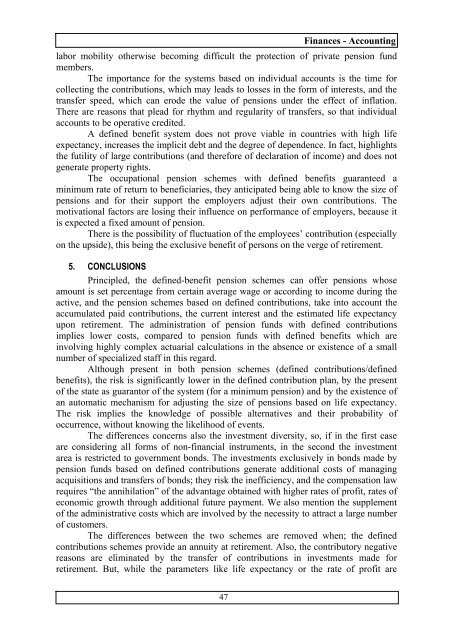Revista Tinerilor Economiºti (The Young Economists Journal)
Revista Tinerilor Economiºti (The Young Economists Journal)
Revista Tinerilor Economiºti (The Young Economists Journal)
Create successful ePaper yourself
Turn your PDF publications into a flip-book with our unique Google optimized e-Paper software.
Finances - Accounting<br />
labor mobility otherwise becoming difficult the protection of private pension fund<br />
members.<br />
<strong>The</strong> importance for the systems based on individual accounts is the time for<br />
collecting the contributions, which may leads to losses in the form of interests, and the<br />
transfer speed, which can erode the value of pensions under the effect of inflation.<br />
<strong>The</strong>re are reasons that plead for rhythm and regularity of transfers, so that individual<br />
accounts to be operative credited.<br />
A defined benefit system does not prove viable in countries with high life<br />
expectancy, increases the implicit debt and the degree of dependence. In fact, highlights<br />
the futility of large contributions (and therefore of declaration of income) and does not<br />
generate property rights.<br />
<strong>The</strong> occupational pension schemes with defined benefits guaranteed a<br />
minimum rate of return to beneficiaries, they anticipated being able to know the size of<br />
pensions and for their support the employers adjust their own contributions. <strong>The</strong><br />
motivational factors are losing their influence on performance of employers, because it<br />
is expected a fixed amount of pension.<br />
<strong>The</strong>re is the possibility of fluctuation of the employees’ contribution (especially<br />
on the upside), this being the exclusive benefit of persons on the verge of retirement.<br />
5. CONCLUSIONS<br />
Principled, the defined-benefit pension schemes can offer pensions whose<br />
amount is set percentage from certain average wage or according to income during the<br />
active, and the pension schemes based on defined contributions, take into account the<br />
accumulated paid contributions, the current interest and the estimated life expectancy<br />
upon retirement. <strong>The</strong> administration of pension funds with defined contributions<br />
implies lower costs, compared to pension funds with defined benefits which are<br />
involving highly complex actuarial calculations in the absence or existence of a small<br />
number of specialized staff in this regard.<br />
Although present in both pension schemes (defined contributions/defined<br />
benefits), the risk is significantly lower in the defined contribution plan, by the present<br />
of the state as guarantor of the system (for a minimum pension) and by the existence of<br />
an automatic mechanism for adjusting the size of pensions based on life expectancy.<br />
<strong>The</strong> risk implies the knowledge of possible alternatives and their probability of<br />
occurrence, without knowing the likelihood of events.<br />
<strong>The</strong> differences concerns also the investment diversity, so, if in the first case<br />
are considering all forms of non-financial instruments, in the second the investment<br />
area is restricted to government bonds. <strong>The</strong> investments exclusively in bonds made by<br />
pension funds based on defined contributions generate additional costs of managing<br />
acquisitions and transfers of bonds; they risk the inefficiency, and the compensation law<br />
requires “the annihilation” of the advantage obtained with higher rates of profit, rates of<br />
economic growth through additional future payment. We also mention the supplement<br />
of the administrative costs which are involved by the necessity to attract a large number<br />
of customers.<br />
<strong>The</strong> differences between the two schemes are removed when; the defined<br />
contributions schemes provide an annuity at retirement. Also, the contributory negative<br />
reasons are eliminated by the transfer of contributions in investments made for<br />
retirement. But, while the parameters like life expectancy or the rate of profit are<br />
47















